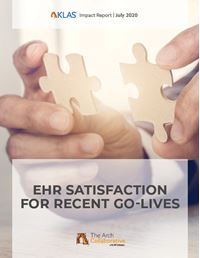EHR Satisfaction for Recent Go-Lives
How Does Time with an EHR Affect Satisfaction?
KLAS’ Arch Collaborative, which has collected EHR-satisfaction data from thousands of clinical end users from hundreds of health systems, has identified and documented three best practices that lead to increased EHR satisfaction. Dubbed the Three Pillars of EHR Satisfaction, these best practices include strong user mastery, an EHR’s ability to meet users’ unique needs, and an organizational sense of shared EHR ownership. This report shows that these best practices are applicable for any acute/ambulatory care organization—regardless of how recently (or not) they implemented their EHR.
Want to see full details?
Want to see full details?
Here is my information:
Findings on the Three Pillars of EHR Satisfaction
Previously published Arch Collaborative reports illustrate how the Three Pillars relate to satisfaction:
- The “Clinician Training” report details the nearly 90-point difference in Net EHR Experience Score (NEES)† between clinicians who strongly disagree initial EHR training prepared them well and clinicians who strongly agree.
- “Improving the EHR Experience through Personalization” found that nearly two-thirds of providers don’t personalize their EHR. Adopting this practice can have an immediate impact; 81% of organizations with high adoption of personalization tools also have above-average EHR satisfaction.
- The “2019 Arch Collaborative Guidebook” highlights how organizations with EHR governance headed up by clinical, administrative, and IT leaders typically score much better than those whose EHR governance is headed by only one of these groups.

†The Net EHR Experience Score (NEES) is a snapshot of clinicians’ overall satisfaction with the EHR environment(s) at the organization. The survey asks respondents to rate factors such as the EHR’s efficiency, functionality, impact on care, and so on. The Net EHR Experience Score is calculated by subtracting the percent of negative user feedback from the percent of positive user feedback. Net EHR Experience Scores can range from -100% (all negative feedback) to +100% (all positive feedback).
Impact of Time with an EHR on Satisfaction
Overall, the longer an organization is live with an EHR, the more satisfied their physicians tend to be. The trend is much less strong for individuals than it is across organizations. This suggests that the amount of time an individual physician has spent with an EHR has less impact on satisfaction than how long the organization has been live. As a result, the rest of this report focuses on the latter measurement.
Key Finding #1:
Initial training has a dramatic and immediate impact on physicians’ EHR satisfaction, even for recent go-lives.
Arch Collaborative data shows that the quality of users’ initial EHR training (i.e., how strongly they agree that their initial training prepared them well to use the EHR) is a key indicator of EHR satisfaction. The effects of strong training are not lessened by how recent (or not) the EHR go-live was. Training is most effective when it is specific to users’ needs and delivered by high-quality educators.

Key Finding #2:
Even amid the inevitable struggles of a new go-live, efforts to improve trust in IT and physician support can still have a significant, positive impact on EHR satisfaction.
Shared EHR ownership also impacts satisfaction regardless of go-live timing. Trust in IT (measured through clinician agreement that the organization effectively implements and supports the EHR) is the related metric that is most under an organization’s control. Organizations that went live before 2017 and those that went live in 2017 or later both see a difference in NEES of over 100 points between those who report the strongest trust in IT and those who report the weakest. Even during the inevitable difficulties of a new EHR implementation, organizations that provide strong support and take ownership for EHR success help physicians feel much more satisfied with their EHR.

Key Finding #3:
Personalizing the EHR has a significant impact on satisfaction—in both the short term and the long term.
Personalization of the EHR can have a significant effect on EHR satisfaction, regardless of go-live timing. Organizations who went live prior to 2017 and those who went live in 2017 or later both have a difference in NEES of over 40 points between physicians with high personalization versus those with little or none. Some high-satisfaction Arch Collaborative members suggest giving physicians a strong foundation in EHR workflows and functions—and then introducing personalization to allow each user to tailor their EHR experience.

Report Non-Public HTML Body
Report Public HTML Body
This material is copyrighted. Any organization gaining unauthorized access to this report will be liable to compensate KLAS for the full retail price. Please see the KLAS DATA USE POLICY for information regarding use of this report. © 2019 KLAS Research, LLC. All Rights Reserved. NOTE: Performance scores may change significantly when including newly interviewed provider organizations, especially when added to a smaller sample size like in emerging markets with a small number of live clients. The findings presented are not meant to be conclusive data for an entire client base.



